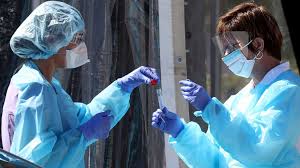27 August 2021
In terms of influence over Australia’s vaccination program, nothing has been more significant than the fact that, from the beginning, there has been an overall shortage of supply. This has cast a dark shadow over all aspects of the program.
Details of the schedule for receipt of vaccine supply must determine absolutely the timing of vaccinations and which groups of people will be first. The public has been kept in the dark about this delivery schedule.

Agreement on the priorities for allocation of vaccine will be critical for as long as there is a supply shortage.
Public debate on the matter has been impossible because most of the planning and management has been done secretly. A sad and surprising feature of the response to the covid pandemic has been the failure to assemble, analyse and utilise data on all aspects of the phenomenon and to keep the public informed. There is so much the public (and, apparently, researchers) don’t know about a disease that threatens everyone.
In the lead-up in Australia to the availability of vaccines and in the first stages of their application, the most important criterion for their allocation was a judgement about which groups or classes of people were ‘the most vulnerable’.
Decision makers and commentators could, in effect, hide behind the phrase. No-one would argue against vaccinating ‘the most vulnerable’ first. However someone – in the case of vaccines, governments – had to convert the phrase into action. They have to decide whether to allocate the last vial of vaccine, as it were, to an elderly person, a nurse, an infant, a mobile 25-year old, someone with a disability, an Aboriginal or Torres Strait Islander person, or a worker in the hotel quarantine system. The decision is difficult and has ethical, practical, clinical, economic and global implications.
To this vulnerability criterion were added practical, commonsense criteria about the potential seriousness of the impact on health and other essential services of sickness and the resulting absence of members of their workforce.

Largely because the processes in train were not under any single agency’s control, management of the early days of the vaccination program was missing. There was no national leadership and an extraordinary absence of urgency. Things just drifted.
It seemed as if the standard dynamic in play was for political pressure to be applied to the Commonwealth, following which it ‘got off the hook’ by announcing some new initiative, with the actual operationalisation of the decision falling to the States and Territories or to GPs. This was the case, for instance, with the sudden weekend announcement in April 2021, just a week before the first general practices were due to come online, that over 4,500 general practices would be providing vaccination. Very little vaccine was actually available to GPs and their phone lines ran hot with frustrated patients.
Initiatives such as pop-up and drive-through vaccination clinics, local support for local rollout to specific cultural groups, and a flying-squad type approach to communities facing special risks were slow to emerge, despite the demonstrated success of such activities in other countries.
The media and other leaders of the debate about covid must take some of the blame for the fact that, even after all these months, the priorities first agreed (those groups allocated to category 1a) have not yet been fully vaccinated. We have allowed the debate about vaccination to move on from one priority to another without any care about whether those of the highest order have first been met.
Delta has re-written the story. With the Delta variant rampant the competition for scarce vaccine has become even stronger. Given the second wave in Sydney and the rest of NSW, the balance between various criteria for prioritisation has shifted. It is no longer agreed that ‘vulnerability’ is the key criterion and that a focus on minimising death and serious illness after infection is the standout purpose.

Rather, vaccination is now a key asset in the battle to limit the number of infections. The new key criteria for allocation include geographical and demographic characteristics. Where you live and what contribution you are likely to make to spread of the disease have become as important as the extent to which your health is likely to be severely affected by the condition.
This means that some of the priority tasks originally agreed are in danger of remaining unfinished. This is likely to have serious implications for the groups affected such as the elderly, Aboriginal and Torres Strait Islanders, hospital staff and people with a disability.
The Federal Government has permitted this change, but it has not led on it. It has been the States and Territories and their health advisers who have taken the lead.
Ironically, with the narrative changing from the suppression of cases to ‘living with covid’, the main purpose of vaccination will to some extent switch back and once again be to minimise illness and death.
The most urgent challenge is to complete the work contingent upon the original priorities, including complete coverage of patients and staff in residential healthcare, aged care and disability facilities.
From 17 September all staff of residential aged care facilities will be required to have had at least one dose. One assumes that the number of doses allocated for this purpose has been checked off against the schedule of vaccine supply.
Such an approach illustrates the fact that the exercise is akin to a complex logistical exercise in planning and management of stocks and flows. Such challenges are familiar to the defence force, for example when it engages in war games or assistance after a natural disaster. It is therefore good to have the military involved.

The Commonwealth must provide the public with more and more detailed data. It must also lead on seeing that Australia is a strong contributor to global and regional initiatives to support vaccination programs in poorer nations.
With greater understanding of the importance of vaccination and how decisions relating to it are made, people are likely to be more invested in the vaccination campaign and thus be more willing to comply with and support it.
